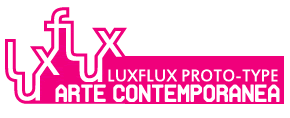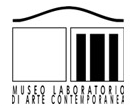Of course art may be – as Laura tells us – only a prey that has eluded the cosmetic use that the current cultural and political system would make of it.
What is left? What is left are the remains of truths about man and fragments of man’s works that were once unitary, functional, and/or symbolic, and as such have also gotten lost inside us forever.
The affirmation of such losses is not pathetic. Detachment from origins is total. But a new origin presents itself: archetypal, in everyday life, in life.
The practice of drawing, the images’ hatching technique, exercised not only on paper, as tradition would have it, but also on canvas and upon a wall, is chosen yet again by Laura Palmieri as a means to jot down and communicate to us her mental images or her interior perception of actual life and its phantasms.
They consist in idols of communication that the artist and we share: they are raised through the heat of pictorial matter – black or colored Indian ink and graphite – to the dignity of art, of an art that no longer has value and that nevertheless reaffirms itself phantasmatically, like the phantasms that it conveys: dead pieces of city, shells; live bodies.
Roma o Morte (“Rome or Death”) on a floor-marking string cornice (Giuseppe Garibaldi), Fiat building (by now abandoned), Porta Maggiore – the baker’s tomb, Termini Station, Nuraghe, Ostia Post Office, Post Office by Adalberto Libera at the Pyramid, Latrine at Ostia antica. As well as Giraffes, She-bear and Cub, Suricate, Sea Animal, Koala, Mouse, Louse, Frog, Hippopotamus.
The first possible strategy of communication with anyone who approaches her is made of materiality and presence. It intertwines with the second: made of absence, of emptiness. The base has no signs, there is neither story nor context. The third and last – albeit in reality the first both in terms of creative process and our perception – is the uncommon association of animals and architectural objects. Out of the empty base come forth animated beings, hungry, sleeping, dozing, threatening and out of proportion, attached like snails to left-over pieces of once-animate architecture.
The first impact is a message of mental alienation and of confused interruption of the connection with reality: the loneliness of the object and of its image.
But the artist – if we come closer – reassures us: the great She-bear pulls her cub onto the flat roof of Mazzoni’s block-like Termini Station, in the shadow of the cylindrical Water Tower that many postmodern artists have immortalized and our eyes distractedly follow every time we go down parallel streets and underpasses; the Hippopotamus is sleeping over the cry that Garibaldi is said to have let out on 18 August 1862 during his stay in Catania, the night before setting out on his campaign for freedom and Italian unity; the She-bear embraces the marble oven-mouths of the tomb of Virginio Eurisace, in front of which screech the trolley-cars that turn and head out towards the suburbs, coming and going through the Porta Maggiore in the Aurelian walls; the Louse scratches the cornice of the Temple of Vesta; the twin Zebras parade their striped mantles like a Rorschach blot as they tower over the Romanesque church of S. Trinità di Saccargia, which dates back to 1116; a Phascolarctos Cinereus or Koala looks at us while clutching the bomb’s tree; the Giraffe lying on the public latrine at Ostia antica blends its coat with a piece of ancient opus reticulatum (“why we can say we are Africans” notes Palmieri in the archival file). Only the interior of an Italian prison is devoid of animated objects: at the center hangs the rope used by those who committed suicide; at the sides, four Rauschenbergian beds hang from the walls of the cell, which is too small to accommodate them.
The persistence of life is a form of ironic and postmodern dramatization: which doesn’t rule out anger and ire.
The sculpture Circe (the preparatory sketch for which says: Pigs and tennis court in red and white ceramic) and the India ink of the porcino carry a whole batch of quintessentially negative energies, coupled with a sport – and therefore a structure – that is bourgeois par excellence: tennis, while around the court wherein it is played the piglets rummage, get the game wrong (are they set to play Puss in the corner?). It constitutes the first project in the series of animate/inanimate bodies without humans and an archetypal reference to Giordano Bruno’s Cantus Circaeus (1592). In the Cantus‘s frontispiece, a pig (or boar) is represented as a first example of the swinish personality, one of the many aptitudes of man – which Bruno identifies with the various animals – that are masked by the human body. All immaterial energies that indiscriminately assume some material form or another, and can animate bodies either human or animal.
There is a critical autobiographic element (both Brunoian: the wickedness and obsessiveness of his contemporaries in relation to his theories; and pertaining to the artist herself, deployed against a sort of maternal/ideological intrusiveness); its apparition occurs as a result of an archetypically founded automatic reaction.
But, in a more general sense, Laura Palmieri’s current work represents the latest, most recent form of her yearning to understand the state of things, to live from day to day like everybody else, to accept the automatic character of movements (human/animal), to intercept the mechanism – jammed or not, as the case may be – of the most ordinary gesture.
Laura Palmieri is always a painter: interception has always taken place via an artistic craft (painting, drawing). But Laura is a conceptual artist, such is her manner of making use of painting, as when in the Variazioni minime she employs an ink jet to variably layer systemic forms and when she opts for art’s most bare and non-symbolic mark, the hatched line: she used it in the series of “emptyings”, in which it hacked at the dead body of the reproduced image, grafting pieces of painting and painted hatch-marks upon randomly chosen fragments of images of ports, of city skylines, of family snapshots, or group sports sequences (Estetica dello sport).
She has articulated emptiness and extended it to the point of causing non-symbolic painting and drawing – abstract but depictive, exalting the contrast between life and its communicative shells – to become part and parcel of it. Laura Palmieri, in other words, affirmed a way of art outside the rules of the art system as it had presented itself to her in her early youth, at the end of the eighties: the era of the vanishing of the role of the artist and of art.
Laura Palmieri has noted, traveled, and mapped the entire poisonous path that has led to the widespread superficialization that one perceives today.
Beyond the lucid pessimism of her ideal masters – first and foremost amongst whom is her putative father Manfredo Tafuri – Laura Palmieri has covered, in the different movements of her work as an artist, all the stages of a foregone conclusion.
But flesh, body, man: what has been done to him, where is he, what is he thinking?


